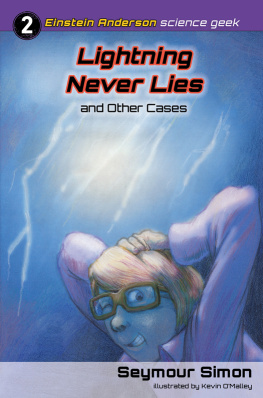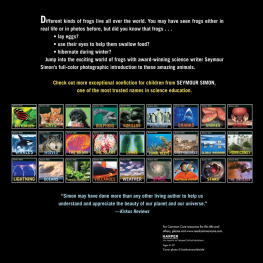CONTENTS
Guide


Visit FableLearning.com
For more great books!
W hen its raining heavily, some people say that its pouring cats and dogs. Of course, thats only an expression. Cats and dogs really dont rain down from the sky. (Although there may be poodles in the street.) But dont be too sure that it never rains animals.
Here is a quote from the July 12, 1873, issue of the magazine Scientific American: A shower of frogs, which darkened the air and covered the ground for a long distance, is the reported result of a recent rainstorm at Kansas City, Mo.
And this is by no means the only reported observation of animal showers. Here is a report from an 1841 issue of an English magazine called The Athenaeum: During a heavy thunderstorm, the rain poured down in torrents mixed with half-melted ice, and, incredible as it may appear, hundreds of small fishes and frogs in great abundance descended with the torrents of rain. The fish were from half an inch to two inches [one to five centimeters] long. Many were picked up alive. The frogs jumped away as fast as they could, but the bulk of them were killed by the fall on the hard pavement.
The idea of living things raining down from the sky is difficult to believe. But from ancient times up to the present there have been reports of showers of one kind or another of animals or plants.
In olden times, these living showers were thought to be supernatural. People believed in magic and witches. They believed in good and evil omens. People must have been frightened or pleased, depending upon what rained down. But whatever animal or plant rained down, it certainly seemed to be a miracle.
There are still many stories of strange animal showers. The reports are often printed in magazines or newspapers of the time. Lets look at some of these reports and then see if they can be explained in any scientific way.
Here is a report from Scientific American, February 21, 1891: In some parts of Randolph County, Virginia, this winter, the crust of the snow has been covered two or three times with worms. A square foot (thirty by thirty centimeters) of snow can scarcely be found some days without a dozen of these worms on it.
Another report from Scientific American, in 1877, tells about a rain of snakes in Memphis, Tennessee. Thousands of little reptiles, ranging from a foot to eighteen inches [thirty to forty-five centimeters] in length, were distributed all over the southern part of the city.


A plague of frogs startled the diners in this print. In olden times, people believed that the frogs came from supernatural causes.
A shower of frogs was reported in a 1939 issue of the English journal Meteorological Magazine. Mr. E. Ettles, superintendent of the municipal swimming pool, stated that about 4:30 P.M . he was caught in a heavy shower of rain and, while hurrying to shelter, heard behind him a sound as of the falling of lumps of mud. Turning, he was amazed to see hundreds of tiny frogs falling on the concrete path around the bath. Later, many more were found to have fallen on the grass nearby.
Even turtles seem to have fallen from the sky. Here is a report from a 1930 issue of Nature magazine: During a severe hailstorm in Vicksburg (U.S.A.)a gopher turtle, 6 inches by 8 inches [fifteen centimeters by twenty centimeters], and entirely encased in ice, fell with the hail.
In 1949, a long article appeared in the magazine Science. The author, A. D. Bajkov, was a biologist working for the Department of Wild Life and Fisheries. Here is part of his eyewitness report of what happened in Marksville, Louisiana:
In the morning of October 23, 1947, between seven and eight oclock, fish ranging from two to nine inches [five to twenty-three centimeters] in length fell on the streets and in the yards. I was in the restaurant with my wife having breakfast, when the waitress informed us that fish were falling from the sky. We went immediately to collect some of the fish.
The director of the bank said that he had discovered that fish had fallen by hundreds in his yard, and in the adjacent yard. The cashier of the bank and two merchants were struck by falling fish as they walked toward their places of business about 7:45 A.M . There were spots on Main Street averaging one fish per square yard [square meter]. Automobiles and trucks were running over them. Fish also fell on the roofs of houses.
Bajkov goes on to identify the fish as bass, sunfish, minnows, and shad. These were all freshwater fish found in local waters. The fish that fell that day in Louisiana were absolutely fresh and fit to be eaten, although Bajkov doesnt say whether he ate any of the fish or how they tasted.
As recently as February 1994, thousands of small fish were found in the Australian desert, flapping about in parking lots and on roads. The fish were found just after a rainstorm. A few days later, thousands more fish, this time slightly larger, were found in puddles after five inches (thirteen centimeters) of overnight rain. From 1988 to 1994, there have been three fish falls in this area.
Looking at these reports, it seems clear that at least some actually happened. If these reports are true, then what possible explanations could they have?
In the stories of worms, caterpillars, or insects found on snow or the surface of the ground, heavy rains or melting snows are often mentioned. Perhaps the soil became waterlogged and the worms or insects were driven to the surface from their underground homes.
In most of the other animal showers, windstorms or tornadoes probably lifted the animals into the air and then dropped them some distance away. For example, tornadoes are known to have lifted houses, cars, and even a train locomotive. It is not surprising that a tornado would also have the force to lift fish, frogs, or even a turtle.
However, there are still some strange things that cannot be explained. First, many of the animal showers report only one kind of animal falling. Why should a whirlwind select only frogs one day and not a combination of animals: fish, frogs, turtles? Second, all the animals that fall are often about the same size. Shouldnt a whirlwind pick up animals of different sizes? Third, the animals often fall without any plants or sand along with them. Shouldnt a whirlwind pick up some of the material surrounding an animal?
While we may not know all the answers to the mysteries of falling animals, this much is sure. The next time someone says that it is raining frogs and fish, you better go out and have a look. He or she may be right.
A t 7:17 in the morning of June 30, 1908, the biggest explosion ever recorded anywhere on the earth took place close to the Tunguska River, in a distant part of Siberia. The big bang blew down trees for dozens of miles (more than thirty-five kilometers) in all directions. People and animals were knocked off their feet four hundred miles (six hundred and fifty kilometers) from the center of the blast. The shocks from the explosion were recorded all around the earth. The explosion was so bright that it made the sun appear dark by contrast. The London

















